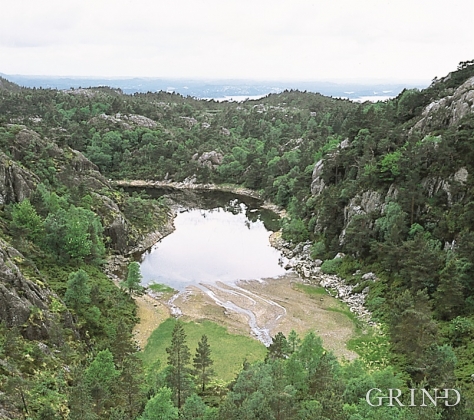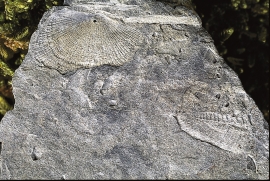Published: 22.07.2015 | Author: Haakon Fossen, Bjørn Neumann
By Lake Dalskarvatnet there have been a number of discoveries of fossils from Ordovician time, among others, of this brachiopod. (Jan Rabben)
450 MILLION YEAR- OLD WESTERNERS
Many of the fossils one finds on Stord are related to fossils of the same age found in North America. Scientists thinks this indicates that the bedrock on Stord was much nearer to America at that time than today.
It is rare to find fossils in western Norway. During the Caledonian mountain-building event the bedrock got strongly folded and flattened, and was exposed to high pressure and temperature. In this way, most of the remains and imprints of organic life have been erased from the rocks. Some fossils were nonetheless preserved, including some on Stord.
In the 1930s the geologist and later professor Anders Kvale discovered several fossils of late Ordovician to early Silurian age (430–450 million years old) by Lake Dalskarvatnet, about 3 kilometres northeast of Dyvik. One can still find fossils in the creek beds that flow out in the east-northeastern part of the lake and in the limestone layer and lenses along the shores. Fossils from Lake Dalskarvatnet reveal the remains of stalks of crinoids, of bryozoans, corals and calcareous algae. Trilobites have also been found and lamp shells (brachiopods) by the water (pictured). Not all are equally whole or well preserved. Many fossils are flattened and folded from the time the Caledonian mountains were formed.
But, fossils have also been found other places in the municipality. Before one began to blast away bedrock in order to build boat houses or piers, Limbuvikjo (from the word "glue", suggesting limestone) by Dyvikvågen was the best place to find fossils in Hordaland. The fossil-bearing layers at Limbuvikjo belong to the same zone and are of the same age as those at Lake Dalskarvatnet.
Fossil
A fossil is a shell, skeletal remain or imprint of an animal or plant preserved in limestone, slate or sandstone. These rocktypes are petrified calcareous sludge, clay or sand deposits. If they were deposited in the area where the animal or plant lived, they often contain fossils. Every geological time period has its characteristic fossils, which in turn can be used to say something of the age of the fossil-bearing bedrock. (Jan Rabben)
- Færseth, R. B., Ryan, P.D. 1975. The geology of the Dyvikvågen Group, Stord,western Norway and its bearing on the lithostratigraphic correlation of polymict conglomerates. Norges Geologiske Undersøkelse Bulletin 319:37–45.





